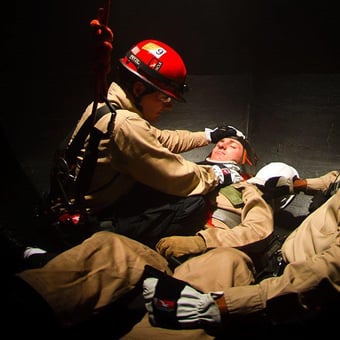Companies with active safety and health programs that train workers to identify hazardous conditions and use required protective measures can prevent serious and fatal injuries.
Father and Two Sons Killed in Grain Silo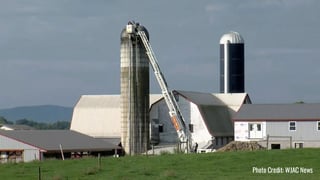 In Centre County, PA, three family members died in a grain silo incident. A father, age 47, and his sons ages 14 and 19 all died after becoming trapped inside a silo. The family members reportedly died from asphyxiation due to gasses in the silo. Neighbors said it was a ripple effect with one going in to help the next when they all eventually succumbed to the hazardous atmosphere inside the space.
In Centre County, PA, three family members died in a grain silo incident. A father, age 47, and his sons ages 14 and 19 all died after becoming trapped inside a silo. The family members reportedly died from asphyxiation due to gasses in the silo. Neighbors said it was a ripple effect with one going in to help the next when they all eventually succumbed to the hazardous atmosphere inside the space.
Tankers Can Be Death Traps
A 48-year-old worker entered a tanker-tailer in Lemont, IL, to inspect it as part of an annual U.S. Department of Transportation requirement and was overcome by exposure to bleach and chlorine gas. The worker was found unconscious in the tanker-trailer; however, he later died of his injuries.
An OSHA investigation determined that the worker’s employer had failed to:
- identify and evaluate atmospheric hazards in the confined space,
- train workers on the confined space program, and
- ensure employees filled out a confined space permit before entry into a confined space.
OSHA also found that the employer failed to equip the worker rescuing the unconscious employee with a retrieval system, implement its own procedures for summoning rescue and emergency services and numerous other violations of its permit-required confined space regulations.
The company was also cited for failing to provide fall protection to an employee working on top of tanker trailers and providing training on fall hazards, respirators, and hazard communication.
The Chicago regional office established a Regional Emphasis Program in 2021 due to the dangers involved in inspecting tanker-trailers. The program is designed to reduce the risks tank cleaning workers face.
“In recent years, OSHA has investigated instances in which workers suffered tragic injuries because employers failed to follow appropriate procedures for ensuring healthy atmospheric conditions inside a confined space and use of adequate respiratory protection before allowing workers to enter tanks,” explained the OSHA Area Director.
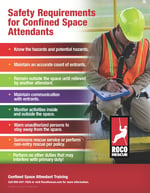
Additional Resources
- Attendant Safety Requirements Poster (pictured here)
- Confined Space Entry Checklist
- Common Causes of Confined Space Fatalities

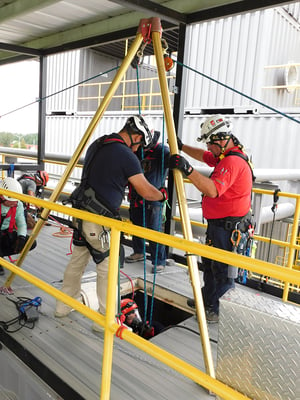
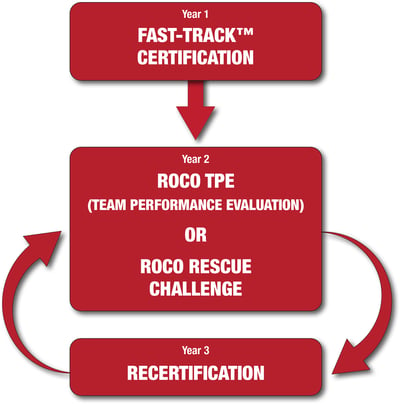 Conclusion
Conclusion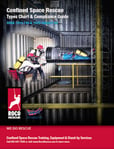
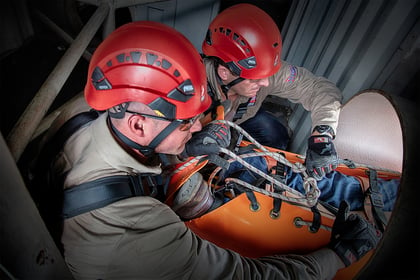 If entering permit-required confined spaces is performed at your worksite, then this is a question you absolutely should be asking yourself. And if you are, that is a good thing; it implies knowledge of OSHA’s requirement that an organization must provide for the safety of their personnel working in confined spaces.
If entering permit-required confined spaces is performed at your worksite, then this is a question you absolutely should be asking yourself. And if you are, that is a good thing; it implies knowledge of OSHA’s requirement that an organization must provide for the safety of their personnel working in confined spaces.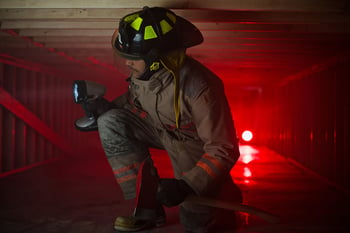 Upon learning that using local emergency services is potentially an allowable confined space rescue option, many organizations see this as the easy choice and quickly check that box. They are thrilled that they are not having to spend any money or devote any personnel to the task. These entities may also secretly wonder what all the hubbub is about regarding confined space rescue, but they very well may learn the hard way should an incident occur.
Upon learning that using local emergency services is potentially an allowable confined space rescue option, many organizations see this as the easy choice and quickly check that box. They are thrilled that they are not having to spend any money or devote any personnel to the task. These entities may also secretly wonder what all the hubbub is about regarding confined space rescue, but they very well may learn the hard way should an incident occur.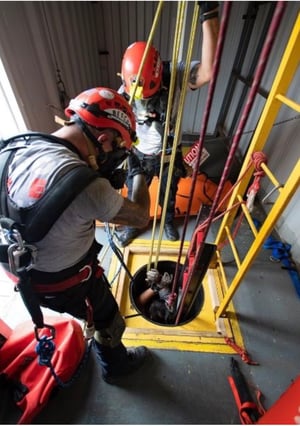 When contemplating the utilization of in-house teams, it is important to note the composition of most. It is the rare organization that staffs personnel whose sole job it is to provide confined space rescue and standby services. Most in-house teams consist of personnel who have other jobs, e.g., operators, engineers, maintenance persons, etc., who are trained to provide rescue and thus called out for standbys or actual emergencies.
When contemplating the utilization of in-house teams, it is important to note the composition of most. It is the rare organization that staffs personnel whose sole job it is to provide confined space rescue and standby services. Most in-house teams consist of personnel who have other jobs, e.g., operators, engineers, maintenance persons, etc., who are trained to provide rescue and thus called out for standbys or actual emergencies.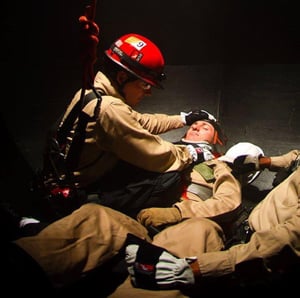 This brings us to the third option—contracted rescue services. If an organization infrequently performs permit-required entries, this option makes good sense. And it can be a far less expensive option than training, staffing, and equipping an in-house team.
This brings us to the third option—contracted rescue services. If an organization infrequently performs permit-required entries, this option makes good sense. And it can be a far less expensive option than training, staffing, and equipping an in-house team.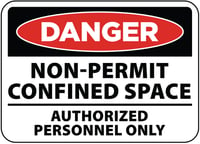 Regardless of which option you choose for confined space rescue services, it is important that you do it right. If you are contracting out the provision of rescue, you are obligated to thoroughly investigate the provider’s credentials and client references. You can be assured that when an accident happens, OSHA will perform a forensic review of your documentation and your policies, as well as those of your rescue service. If you have skipped a step or only addressed them in cursory fashion, OSHA will discover it and potentially issue citations and fines. But one should never lose sight of the fact that the real loser in this scenario is the employee who receives poor or delayed care during the emergency.
Regardless of which option you choose for confined space rescue services, it is important that you do it right. If you are contracting out the provision of rescue, you are obligated to thoroughly investigate the provider’s credentials and client references. You can be assured that when an accident happens, OSHA will perform a forensic review of your documentation and your policies, as well as those of your rescue service. If you have skipped a step or only addressed them in cursory fashion, OSHA will discover it and potentially issue citations and fines. But one should never lose sight of the fact that the real loser in this scenario is the employee who receives poor or delayed care during the emergency.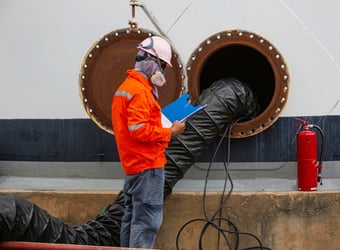
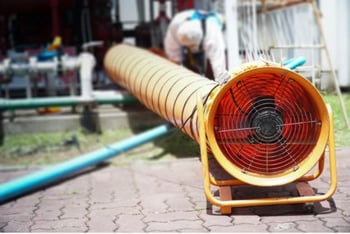 At the declaration of an emergency, deploying ventilation and performing air monitoring should occur concurrently with size up. Starting ventilation is like applying a cervical collar at the scene of an automobile accident; it is one of those things you know you are going to perform each and every time. And while it is expected that everyone will be appropriately trained, ventilation can be handled by support personnel while the rescue technicians are readying for entry.
At the declaration of an emergency, deploying ventilation and performing air monitoring should occur concurrently with size up. Starting ventilation is like applying a cervical collar at the scene of an automobile accident; it is one of those things you know you are going to perform each and every time. And while it is expected that everyone will be appropriately trained, ventilation can be handled by support personnel while the rescue technicians are readying for entry.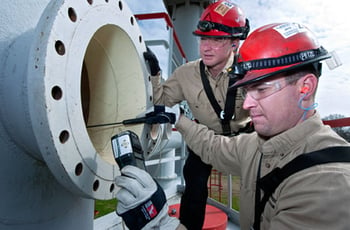 Just as important as the fans is a solid air monitoring plan. The rescuers should be aware of the potential atmospheric hazards and have obtained the appropriate monitoring equipment. The air monitoring should continuously measure the entire space with results constantly provided to the vent team; this allows for adjustments if a particular part of the space is not seeing the expected improvements in air quality.
Just as important as the fans is a solid air monitoring plan. The rescuers should be aware of the potential atmospheric hazards and have obtained the appropriate monitoring equipment. The air monitoring should continuously measure the entire space with results constantly provided to the vent team; this allows for adjustments if a particular part of the space is not seeing the expected improvements in air quality.